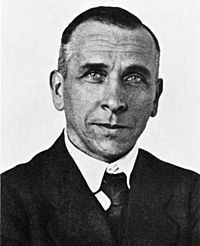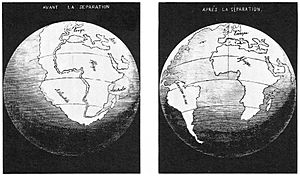Alfred Wegener facts for kids
Quick facts for kids
Alfred Wegener
|
|
|---|---|

Alfred Wegener, about 1925
|
|
| Born | 1 November 1880 |
| Died | 13 November 1930 |
| Nationality | German |
| Alma mater | University of Berlin |
| Known for | continental drift |
| Scientific career | |
| Fields | meteorology geology |

Alfred Lothar Wegener (born November 1, 1880 – died November 13, 1930) was a German scientist. He was a meteorologist, which means he studied weather and the atmosphere. He is most famous for his idea of continental drift.
Wegener suggested in 1912 that the continents on Earth were slowly moving around. He also had ideas about why they moved. At first, many other scientists thought his ideas were impossible. His theory was not fully accepted until the 1950s. That's when new discoveries proved that continents do indeed drift.
Wegener was born in Berlin, Germany. In 1904, he earned his PhD in Astronomy from the University of Berlin. During World War I, he served in the German Army. He was wounded and later worked in the army weather service. After the war, he mostly focused on weather studies.
Contents
Alfred Wegener's Early Life and Studies
Alfred Wegener was born in Berlin on November 1, 1880. He was the youngest of five children. His father was a clergyman and a teacher. In 1886, his family bought a vacation home near Rheinsberg. Today, there is a memorial site for him there.
Wegener went to school in Berlin at the Köllnisches Gymnasium. He was the best student in his class. A special plaque on the building remembers this fact.
He studied Physics, meteorology, and Astronomy in Berlin, Heidelberg, and Innsbruck. One of his teachers was Max Planck, a famous physicist. Planck taught him to be clear and careful with his scientific ideas.
In 1905, Wegener started working at an observatory near Beeskow. He worked with his older brother, Kurt, who also studied weather. They were pioneers in using weather balloons to track air masses. In 1906, the Wegener brothers set a record for the longest continuous balloon flight. They stayed in the air for 52.5 hours!
Understanding Plate Tectonics
The idea that continents move had been suggested before. A mapmaker named Abraham Ortelius thought about it in the 1500s. But Alfred Wegener was the first to gather a lot of evidence for it.
Wegener's Continental Drift Theory
Wegener used different types of evidence to support his theory of continental drift. He looked at geological features, fossils, and signs of ancient glaciers. He found these clues on continents that are now far apart.
For example, he noticed that the Appalachian Mountains in North America looked like the Scottish Highlands. He also saw that rock layers in South Africa and Brazil were very similar.
Wegener believed these similarities could only be explained if these places were once part of the same giant continent. He thought that continents float on the denser rock of the ocean floor. He said they slowly move across it. Even though his theory explained many things, he couldn't fully explain how the continents moved.
Why Some Scientists Doubted Him
Many Earth scientists and palaeontologists did not believe Wegener's theory. They thought it was a strange idea. Some critics suggested that huge land bridges could explain the similar fossils in South America and Africa.
Others argued that Wegener's theory didn't explain the strong forces needed to move continents. Wegener thought that the Earth's rotation and other forces caused the movement. He also thought these forces caused earthquakes and volcanic eruptions.
The British geologist Arthur Holmes was one of the few who supported Wegener's idea. In 1931, Holmes suggested that the Earth's mantle had convection cells. He thought these cells moved the Earth's crust.
Proof for Continental Drift
In the 1950s, scientists made important discoveries. They found evidence of sea-floor spreading and magnetic reversals in the mid-atlantic ridge. These discoveries proved that Wegener's theory was real. They led to the modern theory of plate tectonics.
Today, geologists know that continents are parts of huge moving tectonic plates. These plates float on a layer of partly melted rock called the asthenosphere.
Alfred Wegener's Family Life
In 1913, Wegener married Else Köppen. She was the daughter of his former teacher, the meteorologist Wladimir Köppen. They lived in Marburg, where Wegener taught at the university.
Their two older daughters, Hilde and Sophie, were born there. Their third daughter, Hanna Charlotte, was born in Hamburg.
Alfred Wegener's Death
Alfred Wegener died in Greenland in November 1930. He was on an expedition to deliver food to a group of researchers. They were camped in the middle of a huge icecap.
Wegener successfully brought supplies to the camp. But there wasn't enough food for him to stay. So, he and a colleague, Rasmus Villumsen, left by dog sled to go to another camp. They never reached it.
Villumsen carefully buried Wegener's body. He marked the grave with a pair of skis. Villumsen then continued his journey, but he was never seen again.
Six months later, Wegener's grave was found. Expedition members built a pyramid-shaped mausoleum of ice and snow over his body. Wegener was 50 years old and a heavy smoker. It is believed he died of heart failure from overworking. Villumsen was only 23 when he died. Their bodies are now under more than 100 meters (300 feet) of ice and snow.
Awards and Ways He is Remembered
Many things are named after Alfred Wegener to honor his work:
- The Alfred Wegener Institute for Polar and Marine Research in Germany.
- The Wegener Medal, awarded by the institute.
- A crater on the Moon called Wegener.
- A crater on Mars also called Wegener.
- An asteroid named 29227 Wegener.
- A peninsula in Greenland where he died (Wegener Peninsula).
The European Geosciences Union also gives an Alfred Wegener Medal. It honors scientists who have made amazing achievements in atmospheric, water, or ocean sciences.
Images for kids
-
Original world maps created by Alfred Wegener showing Pangaea and the continents drifting apart.
See also
 In Spanish: Alfred Wegener para niños
In Spanish: Alfred Wegener para niños







